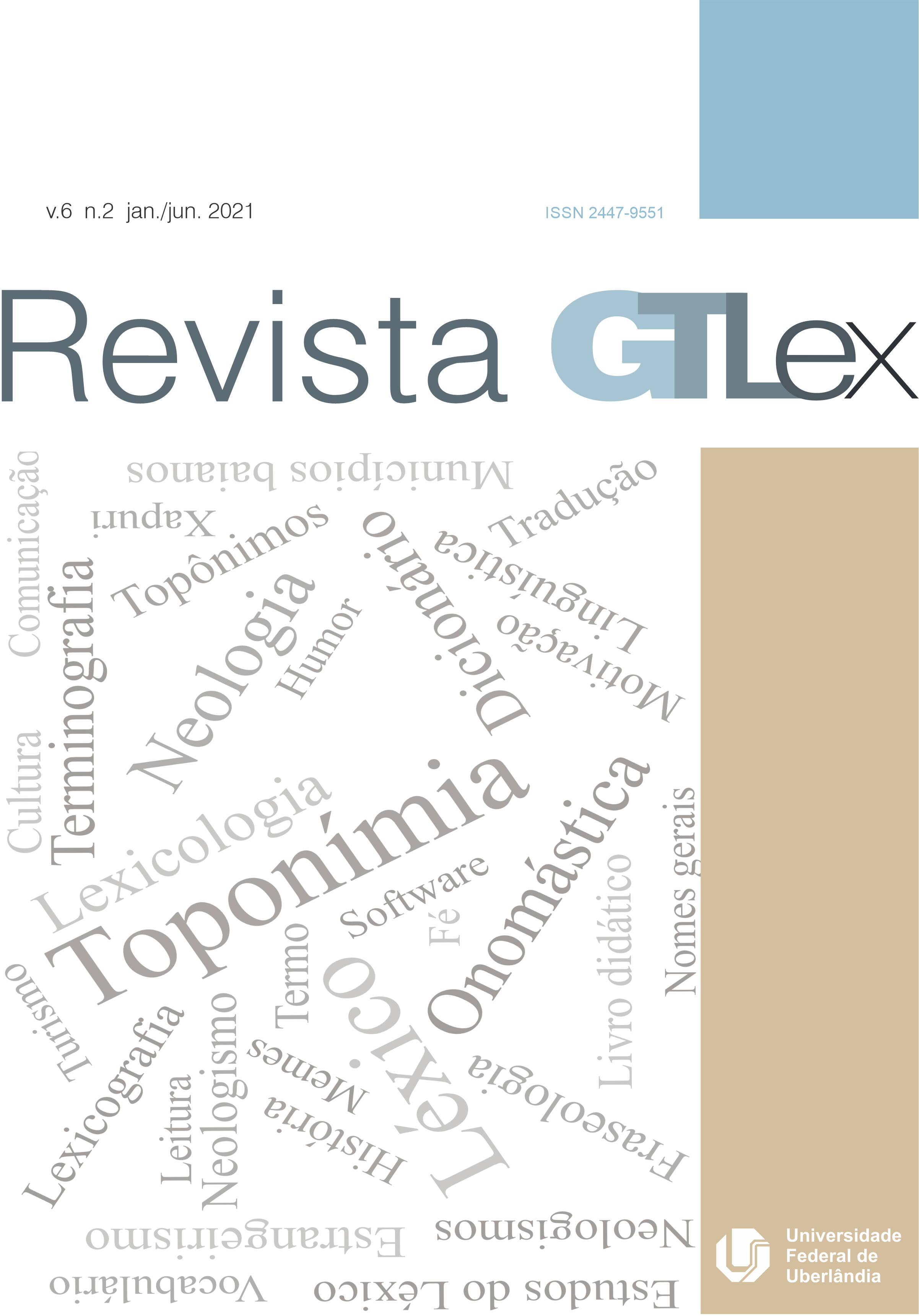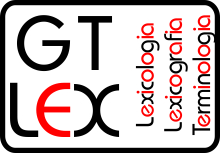In search of traces of lexical conservatism
a study in Espírito Santo speech
DOI:
https://doi.org/10.14393/Lex12-v6n2a2021-4Keywords:
Lexicon, Linguistic Conservatism, Diatopic variation, GeolinguisticsAbstract
This work aims to discuss the relationship between the lexicon and the phenomenon of linguistic conservatism, based on the examination of a sample of the vocabulary of speakers from four cities in the interior of the state of Espírito Santo, documented by the research team of the ALiB Project (Linguistic Atlas of Brazil). The analyzed lexical data were obtained through questions 075, 076, 077 and 078, from the ALiB Project's Semantic-lexical Questionnaire, semantic area of fauna, more specifically the parts of the horse and ox. The study is guided by theoretical foundations of Lexicology, Dialectology and Geolinguistics and seeks to verify, from a diatopical point of view, the presence of factors of a historical and socio-cultural nature that may contribute to the process of lexical conservation in the speech of representative groups of cities in the interior of Brazil, in the case of the state of Espírito Santo. In summary, the study demonstrated aspects of the relationship between the lexicon and the social history of the locations surveyed, in addition to pointing out signs of conservatism in the vocabulary of the investigated group.
Downloads
References
AMARAL, A. O dialeto Caipira. 3ª. ed. São Paulo: Hucitec, 1976.
ARAÚJO, J. de S. A. P. e. Memorias históricas do Rio de Janeiro e das províncias anexas à jurisdicção do Vice-Rei do Estado do Brasil. Rio de Janeiro: Imprensa Régia, 1820. Biblioteca digital do Senado. v. 2. Disponível em: https://www2.senado.leg.br/bdsf/item/id/182898 . Acesso em : 24 out. 2019.
ASSUMPÇÃO, JR. A. P. Dinâmica léxica portuguesa. Rio de Janeiro: Presença, 1986.
AULETE, F. J. C.; VALENTE, A. L. dos S. Aulete Digital: Dicionário Contemporâneo de Língua Portuguesa. Rio de Janeiro: Lexikon Editora Digital, 2006. Disponível em: http://aulete.com.br. Acesso em : maio 2021.
BLUTEAU, R. Vocabulário Portuguez & Latino. Coimbra: Colégio das Artes da Companhia de Jesus, 1712-1728. (Acervos on-line). Disponível em: https://www.bbm.usp.br/pt-br/dicionarios/. Acesso em: 10 nov. 2019.
BIDERMAN, M. T. C. Teoria lingüística. Teoria lexical e lingüística computacional. São Paulo: Martins Fontes, 2001.
BIDERMAN, M. T. C. O léxico, testemunha de uma cultura. XIX Congresso Internacional de Linguística e Filoloxia Romanicas, 1992, Santiago de Compostela. Actas do XIX Congreso Internacional de Linguistica e Filoloxia Romanicas. A Coruña: Fundación Pedro Barrié de la Maza, Conde de Fenosa, 1989, p. 397-405.
BIDERMAN, M. T. C. Conceito lingüístico de palavra. Palavra. n. 5, Rio de Janeiro: Grypho, p. 81-97, 1999. DOI https://doi.org/10.11606/issn.2176-9419.v0i2p81-118
CARDOSO, S. Geolinguística: tradição e modernidade. São Paulo: Parábola Editorial, 2010.
CARDOSO, S. et al. Atlas Linguístico do Brasil. Vol. 1 (Introdução). Londrina: EDUEL, 2014a.
CARDOSO, S. et al. Atlas Linguístico do Brasil. Vol. 2 (Cartas Linguísticas). Londrina: EDUEL, 2014b.
COMITÊ NACIONAL DO PROJETO ALiB. Atlas Linguístico do Brasil: Questionários 2001. Londrina: EDUEL, 2001.
CUNHA, C. Conservação e inovação no Português no Brasil. O eixo e a Roda. Belo Horizonte, n. 5, p. 199-230, 1986. DOI https://doi.org/10.17851/2358-9787.5.0.199-230
CUBA, M. A.; ISQUERDO, A. N. Vocabulário da área semântica do cavalo na região Centro-Oeste: um estudo com dados geolinguísticos. Estudos Linguísticos e Literários. Salvador, n. 41, p. 259-290, janeiro/junho, 2010.
DIEGUES JUNIOR, M. Regiões Culturais do Brasil. Rio de Janeiro: MEC. INEP. Centro Brasileiro de Pesquisas Educacionais, 1960.
DUBOIS, J. et. al. Dicionário de linguística, 19ª ed. São Paulo: Cultrix, 1993.
FERREIRA, A. B. de H. Novo dicionário Aurélio da língua portuguesa. 4 ed. Curitiba: Ed. Positivo, 2009.
HOUAISS, A. Dicionário Eletrônico Houaiss da Língua Portuguesa. Rio de Janeiro: Objetiva, 2001.
IBGE – INSTITUTO BRASILEIRO DE GEOGRAFIA E ESTATÍSTICA. Região Sudeste. Disponível em: https://www.ibge.gov.br/estatisticas/sociais/populacao/9103-estimativas-de-populacao.html?=&t=downloads. Acesso em: 15 maio 2021.
IBGE – INSTITUTO BRASILEIRO DE GEOGRAFIA E ESTATÍSTICA. Barra de São Francisco. Disponível em: https://biblioteca.ibge.gov.br/visualizacao/livros/liv27295_22.pdf. Acesso em : 15 maio 2021.
IBGE – INSTITUTO BRASILEIRO DE GEOGRAFIA E ESTATÍSTICA. Cidades. Barra de São Francisco. Disponível em: https://cidades.ibge.gov.br/brasil/es/barra-de-sao-francisco/panorama. Acesso em : 20 maio 2021.
IBGE – INSTITUTO BRASILEIRO DE GEOGRAFIA E ESTATÍSTICA. São Mateus. Disponível em: https://biblioteca.ibge.gov.br/visualizacao/livros/liv27295_22.pdf. Acesso em : 20 maio 2021.
IBGE – INSTITUTO BRASILEIRO DE GEOGRAFIA E ESTATÍSTICA. Santa Teresa. Disponível em: https://cidades.ibge.gov.br/brasil/es/santa-teresa/historico. Acesso em: 15 maio 2021.
IBGE – INSTITUTO BRASILEIRO DE GEOGRAFIA E ESTATÍSTICA. Cidades. Santa Teresa. Disponível em: IBGE: https://cidades.ibge.gov.br/brasil/es/santa-teresa/panorama. Acesso em: 15 maio 2021.
IBGE – INSTITUTO BRASILEIRO DE GEOGRAFIA E ESTATÍSTICA. Cidades. Alegre. Disponível em: https://cidades.ibge.gov.br/brasil/es/alegre/historico. Acesso em: 16 maio 2021.
IBGE – INSTITUTO BRASILEIRO DE GEOGRAFIA E ESTATÍSTICA. Alegre. Disponível em: https://www.ibge.gov.br/estatisticas/sociais/populacao/9103-estimativas-de-populacao.html?=&t=downloads. Acesso em: 16 maio 2021.
ISQUERDO, A. N. Léxico em tempo e espaço: a questão dos regionalismos. In: MARIN, J. R; VASCONCELOS, C. A. (org.). História, região e identidades. Campo Grande: Editora da UFMS, 2003. p. 165-181.
ISQUERDO, A. N. Léxico regional: análise de algumas marcas de conservadorismo linguístico. Estudos Lingüísticos (São Paulo), São Paulo, v. 25, p. 568-574, 1996.
MACHADO, J. P. Dicionário Etimológico da Língua Portuguesa. 4ª ed. Lisboa: Livros Horizonte, 1987.
MATTOS E SILVA, R. V. O conceito relativo de neologismo e arcaísmo: um estudo pancrônico. In: OLIVEIRA, K.; CUNHA E SOUZA, H. F..; SOLEDADE, J. (org.). Do português arcaico ao português brasileiro: outras histórias. Salvador: EDUFBA, 2009. p. 11-20.
MUNICÍPIOS DO ESTADO DO ESPÍRITO SANTO. Densidade. Disponível em: https://www.ibge.gov.br/cidades-e-estados.html?view=municipio. Acesso em 27 nov. 2019.
OLIVEIRA, A. M. P. P. de.; ISQUERDO, A. N. Apresentação. In: OLIVEIRA, A. M. P. P. de.; ISQUERDO, A. N. As Ciências do Léxico. Lexicologia, Lexicografia, Terminologia. 2ª ed. Campo Grande/MS: Editora UFMS, 2001. p. 13-21.
SAUSSURE, F. de. Curso de Linguística Geral. 27ª ed. São Paulo: Cultrix, [1916] 2006.
SILVA, A. de M. Diccionario da língua portugueza. Lisboa, Typographia Lacerdina, 1813. Disponível em: http://www.brasiliana.usp.br/dicionario/edicao/2. Acesso em : 27 nov. 2019.
Downloads
Published
How to Cite
Issue
Section
License
Autores que publicam nesta revista concordam com os seguintes termos:
CC BY-NC-ND 4.0: Autores mantém os direitos autorais e concedem à revista o direito de primeira publicação, com o trabalho simultaneamente licenciado sob a Creative Commons Attribution License que permitindo o compartilhamento do trabalho com reconhecimento da autoria do trabalho e publicação inicial nesta revista.
Autores têm autorização para assumir contratos adicionais separadamente, para distribuição não-exclusiva da versão do trabalho publicada nesta revista (ex.: publicar em repositório institucional ou como capítulo de livro), com reconhecimento de autoria e publicação inicial nesta revista.









